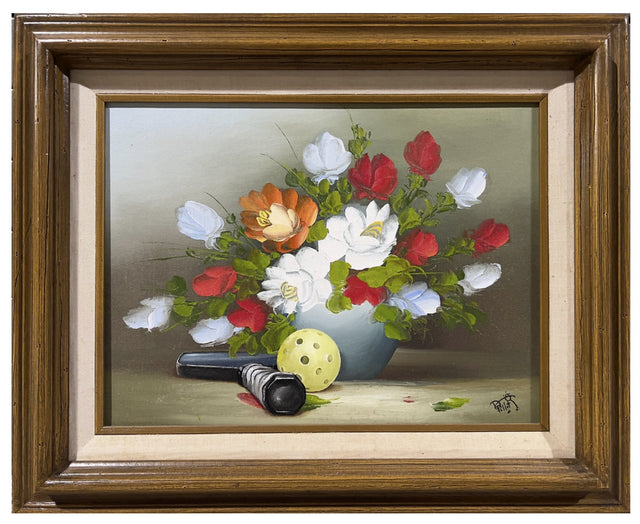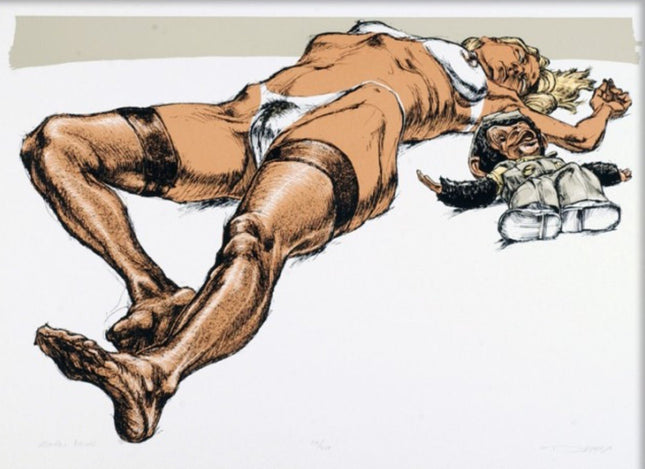
Brown & Tan

Derek Hess Monkey Trick Serigraph Print by Derek Hess
Monkey Trick Limited Edition Hand Pulled 4-Color Serigraph Print on Fine Art Paper by Derek Hess Graffiti Street Artist Modern Pop Art. 2015 SIgned & Numbered Limited Edition of 200, 4 colors and the white of the paper creates the tan lines." - Derek Hess Dissecting Derek Hess's Monkey Trick Serigraph In the intricate dance of colors and lines that characterizes Derek Hess's 'Monkey Trick,' the piece stands out as a testament to the artist's prowess in merging the intensity of graffiti artwork with the finesse of modern pop art. This limited edition, hand-pulled, 4-color serigraph print on fine art paper exemplifies how street art sensibilities can be transformed into gallery-worthy pieces. Hess, an American artist from Cleveland, Ohio, is celebrated for his work, which often reflects struggle, emotion, and human complexity themes. Serigraphy: Melding Street Art with Fine Art The technique used in 'Monkey Trick' is serigraphy, which refers to traditional screen printing methods. By utilizing a mesh to transfer ink onto paper, except in areas made impermeable to the ink by a blocking stencil, Hess showcases his distinctive style—usually seen adorning city walls and skateboards. The statement by Hess, '4 colors and the white of the paper creates the tan lines,' underlines his meticulous methodology. The limited color palette does not limit the depth of the piece; instead, it enriches it, with the white of the paper becoming an active participant in the narrative. This is particularly notable in street pop art, where the environment often contributes to the artwork, just as the paper does here. The surroundings are not mere backdrops but integral components of the art. In 'Monkey Trick,' Hess utilizes the absence of color to suggest presence, much like how the silence in a conversation can speak volumes. It reflects how graffiti artists often must use the canvas of walls, adjusting and incorporating their imperfections and textures into their work. The Visual Language of 'Monkey Trick' The subject matter of 'Monkey Trick' is quintessentially Hess—a complex human figure in repose, suggestive of vulnerability or exhaustion, with a more petite figure, which appears to be a monkey, also in a state of rest. The human figure, rendered in robust, muscular lines, is influential yet passive. The monkey, often symbolizing mischief or playfulness in art, is shown in an unusual moment of calm, mirroring its human counterpart. This duality may reflect the multifaceted nature of humans, who possess both a primal, unrefined side and a more complex emotional capacity. Using only four colors to create this piece speaks to Hess's ingenuity. It challenges the viewer to find depth and texture in limitation, a common theme in street art where artists often work with a restricted palette due to environmental and material constraints. The serigraph embraces street pop art's raw, unfiltered ethos, which thrives on minimalism and directness to convey powerful messages. The lines and tan shades in 'Monkey Trick' create a tangible texture that can almost be felt, reminiscent of the tactile nature of walls that serve as canvases in urban landscapes. The Legacy of Derek Hess and 'Monkey Trick' Derek Hess's work has been influential in bridging the often segregated worlds of street art and fine art. 'Monkey Trick' is a notable example of how graffiti's spontaneity and vivid imagery can be harmoniously blended with pop art. It also indicates Hess's ability to convey complex human emotions through simple yet compelling compositions. This serigraph adds to his legacy as a pioneer in this blended art form. It serves as a cultural artifact, capturing the essence of an era where street art is increasingly recognized as a legitimate and influential art form. Through 'Monkey Trick,' Hess contributes to the dialogue on converging street art techniques with acceptable art principles. His work resonates within the art community and beyond, attracting those who need to be more traditionally engaged with art and inviting them to explore the layered meanings behind the deceptively simple visuals. Pieces like this exemplify how modern street pop art is not just about the art itself but also about the process and the narrative it invites the viewer to partake in. Through his art, Derek Hess asks us to consider the human condition, the rawness of our existence, and the beauty found within the constraints of form and color.
$364.00


